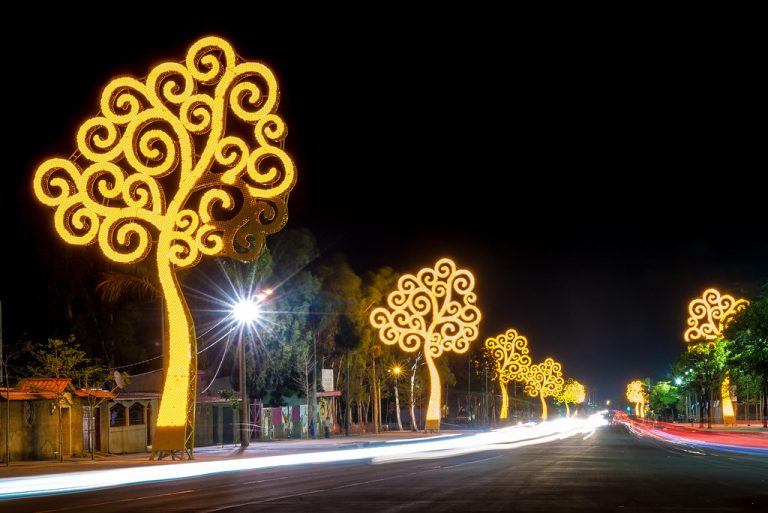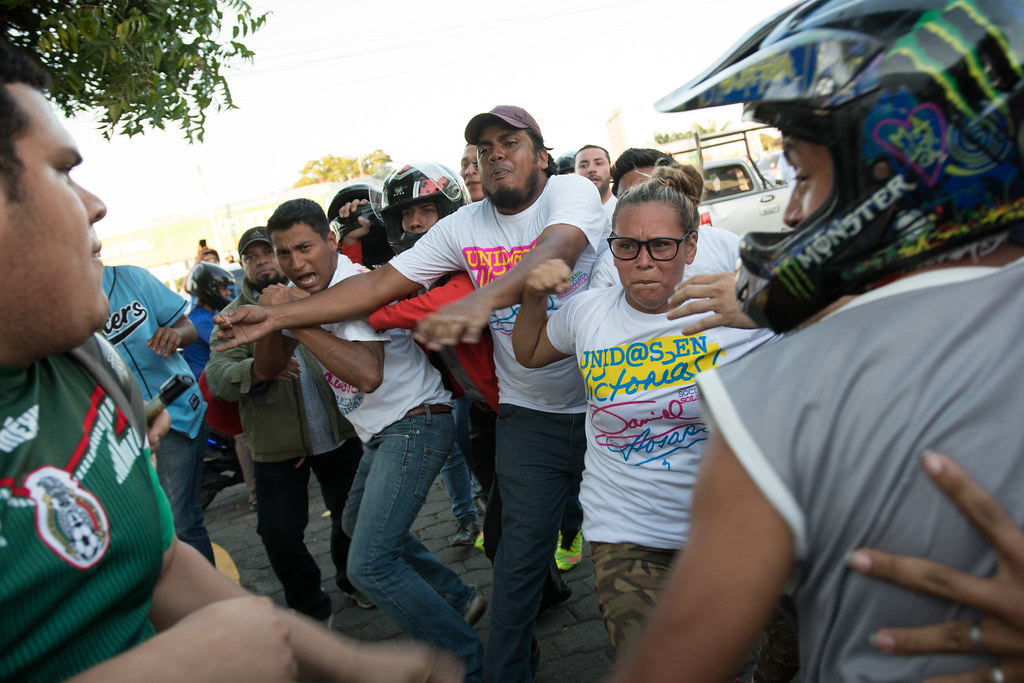4 de septiembre 2020

Children of Exile: The Births “Sowing Hope” in the Camp of Nicaraguan Farmers

PUBLICIDAD 1M
PUBLICIDAD 4D
PUBLICIDAD 5D
“El Bachi”, “Chayopalo”, and “sapo” are some of the terms that Nicaraguans have used to refer to people, events and personalities in the past two years

More than a hundred "Trees of life", commonly known as "Chayopalos", were placed throughout Managua in 2013. Photo: Carlos Herrera | Confidencial
While visiting my family in Leon in April of 2018, I heard the term “sapa” being used to describe one of our neighbors. In the midst of the commotion caused by the violent repression of protests against the government of Daniel Ortega, a rumor began circling that someone in our neighborhood had supposedly given shelter to students who protested against the regime, to then call the National Police, an institution loyal to the president, to turn them in.
Sapo, meaning toad, is the Nicaraguan slang word for snitch. The term has been used for many years in the country, but it was until recently that it became commonly heard, once again, in a political context. Opponents of the regime have been calling state workers and supporters of the Sandinista Liberation Front (FSLN) - the ruling party - “sapos”.
According to sociologist Silvio Prado, nicknames like this one are often used to disqualify the adversary, with the purpose of differentiating one person from “the others”. Prado recalls that during the eighties, the term “sapo” was used in reference to informants of the FSLN, to the point that the Sandinista Defense Committee (CDS) was popularly referred to as “Criadero de Sapos” (freely translated as snitch breeding place).
Another term that gained more relevance in the context of the protests is “Chayopalo”, a word that Nicaraguans use to refer to the “Trees of life” that have been installed throughout Managua since 2013, by instructions of vice president Rosario Murillo.
Chayopalo is composed of two words: “Chayo”, an abbreviation of the name Rosario, and “palos”, which means “trees”. Through this unification of concepts, the symbol of the trees is associated with Rosario Murillo as an individual in the eyes of the public.
When the demonstrations were at their peak, protesters showed their discontent with the regime by knocking down these large metallic structures. When a Chayopalo was knocked down, people took the lightbulbs as souvenirs. Once, I received one as a gift from a guy I had met during the protests. In a joking tone, he let me know that before giving me the lightbulb, he had asked a priest to bless it with holy water, “just in case”.
There are a lot of superstitions in Nicaragua, and people joke about Rosario Murillo’s extravagant way of dressing and her apparent inclination towards mystical and spiritual subjects, some going as far as calling her a “witch”.

A photo of the book "Nicaraguan Spanish. Speak like a native!" by Lee Jamison. Credits: C. Membreño
In the book “The Nicaraguan speech and other essays” (El habla nicaragüense y otros ensayos), published in 1989, the linguist and theologian Carlos Mantica Abaunza already said that it was rare to find a person who didn’t have a nickname in Nicaragua. Even political personalities such as Anastacio Somoza García, one of the country’s dictators, had one. He was called “Tacho”.
While explaining the morphology of Nicaraguan nicknames, Mantica points out an interesting detail: most of the abbreviations used to refer to a man frequently place the letter “ch” at the beginning or the middle of the word.
The linguist wonders if this is a characteristic of the Nicaraguan speech and if it could be an explanation of the Pipil ancestor. “(Pipil) is the name that the Aztecs gave to those who pronounced the Nahuatl in the children’s way,” he says.
This could actually be the case of “El Bachi”, the nickname that Nicaraguans use when talking about Daniel Ortega, president, and dictator. According to the monthly publication Magazine, the term was coined by cartoonist Manuel Guillen, who has popularized different nicknames of political personalities through his work at La Prensa newspaper. These days, “El Bachi” is used to imply that Ortega did not pursue a university education. “Bachi” is the short of “bachiller” (highschool graduate).
In his book, Mantica also mentions something that could explain why many Nicaraguan slang words and nicknames are frequently composed of two words: Nahuatl language has a strong influence in the Nicaraguan speech, and it has an ability to form new words through the juxtaposition of concepts.
In addition, the linguist explains that the Nicaraguan speech lives in perpetual evolution and change and that many of its words - exactly how I’ve witnessed over the years - come from a person, a product, a song, or a social or political event.
Such is the case of Daniel Ortega’s other nickname, which arose in the context of the 2018 protests: Comandante Zekeda.
This term is used ironically, while simultaneously carrying important historical implications. Among his supporters, Ortega is referred to as Comandante due to his participation in the Sandinista Revolution. However, he was in jail most of the time in which Somoza ruled Nicaragua, and later lived in exile in Cuba. He did not actually hold a post as a military commander.
A parallelism that has been drawn in several articles that compare the dictatorships between Ortega and Somoza, is that during Somoza’s last months in power, his supporters chanted “No te vas, te quedas” at a rally - a phrase meaning “you are not leaving, you are staying”.
The phrase “El Comandante se queda” translates into “The commander is staying” and has been used in social media posts, songs and graffiti in support of his government. However, the opposition has now adopted the use of the phrase by misspelling it and using it in a mocking tone: Comandante Zekeda.

Nicaraguans showed their discontent with the Ortega-Murillo regime by knocking down the Trees of Life. Photo: Carlos Herrera | Confidencial
The creation and dissemination of nicknames and slang words during the period of the political protests has been happening at a more rapid pace than previously seen in Nicaragua, states sociologist Silvio Prado.
“It was an ubiquitous phenomenon, present throughout the country. Social, geographical and demographic transversality made the intensity much greater, and the famous social media networks contributed to that. It made the images and words, those cultural products, spread faster,” he details.
Prado, who is also a political analyst, points out that in times of peace and calm, the time needed for the generation and diffusion of symbols is longer. But in political conflicts, and due to the intensity of the struggle, those times are shortened because “the struggle needs symbols.”
These days, nicknames have evolved into general slang of the Nicaraguan population, rather than being limited to a small town or a municipality, he says. “These words have spread and surpassed the limits of small communities, a process that has been facilitated by social media,” Prado states.

Government's spokesperson Rosario Murillo in a public event. Photo: Confidencial
“Chayo” is not the only nickname that Nicaraguans use to refer to vice president and government’s spokesperson Rosario Murillo. She has also been labeled as “Chamuca” for quite some time, a word popularly associated with “witch”.
Silvio Prado recalls that the first time he came across the term Chamuca being used to describe Murillo, was in an illustration by the cartoonist Manuel Guillen, who abbreviated her name to Cha-Mu (coming from Chayo and Murillo).
Overtime, this abbreviation was altered to Chamuca, which is considered more derogatory due to the suffix -ca, Prado notes. Whereas the meaning of Chamuco is devil in other Latin American countries, in Nicaragua, the connotation of witch may have been given to the word later on, in association with Murillo, said Prado.
In her role as government spokesperson, Rosario Murillo has been publicly giving derogatory nicknames to opponents of the regime. Some of them are: “vandálicos” (vandal), “plagas” (plague), “golpistas” (coup plotters), “puchos diabólicos” (diabolical small group), “chupa sangre” (bloodsucker), among many others.
The language used both by Murillo and Ortega has been analyzed by Cindy Regidor, journalist at CONFIDENCIAL, as being part of a hate speech rhetoric, which incites violence and discrimination in the population. The words used nowadays by government supporters often arose from these official speeches.
For international organizations such as the United Nations, the outcome of this kind of behavior is worrying. "In the last 75 years, hate speech has been seen as a precursor to heinous crimes, including genocide, from Rwanda to Bosnia and Cambodia," the entity warns.
Aside from the slang and nicknames associated with individuals, these are some additional terms whose meaning was shaped by the current political context of Nicaragua:

Sympathizers of the Ortega-Murillo regime attack Nicaraguans who protested against the government. Photo: Carlos Herrera | Confidencial
The term Sandinista is adapted from the last name of Augusto Sandino, who fought against the U.S military occupation of Nicaragua in the 1930’s. Sandino was murdered by US-backed dictator Somoza in 1934. Years later, the FSLN was created, overthrowing Somoza in what is known as the Sandinista Revolution in 1979 - when Ortega became president. Over the years, some Nicaraguans have opted for referring to Sandinismo as Orteguismo, a word that indicates that someone is a sympathizer of Daniel Ortega’s regime.
Sociologist Monica Baltodano has stated that within the Orteguista leadership, there are no remnants to be found of Sandinismo. Yet others, like sociologist Miguel Aleman Robleto, argue that the FSLN had authoritarian traits early on, and that if one considers the suffering inflicted under the Sandinista political ideology in the 80s, it is not possible to make the distinction between Orteguismo and Sandinismo.

Relatives of political prisoners visit El Chipote frequently to demand information about their whereabouts. Photo: Carlos Herrera | Confidencial
El Chipote, formally known as Dirección de Auxilio Judicial, is a jail in Managua. Throughout Nicaraguan history, this place has been known under different names for the physical and psychological torture committed against its prisoners. It was used during the Somoza dictatorship as a jail and as a center for torture, employed against those who opposed the then dictator. After the FSLN rose to power in 1979, it served as headquarters for the DGSE (General Directorate of State Security), and was renamed after Sandino’s base camp by the same name, located in Las Segovias.
Following the civic uprising in 2018, hundreds of protestors were arrested, and in 2019, the number of political prisoners in Nicaragua surpassed 800. Several of those arrested spent weeks or months in El Chipote, and harrowing testimonies have come out of this jail. Although the government released a number of political prisoners over the past year, there are still political prisoners illegally detained in El Chipote and other clandestine spots in relation to participating in the protests.

Paramilitaries photographed in the city of Masaya. President Daniel Ortega continues to deny their existence. Photo: Carlos Herrera | Confidencial
The name of this Toyota brand pick up truck became a fixture in the Nicaraguan vocabulary in the months following the civic protests, in reference to the repression by the government. Ortega’s paramilitary forces were regularly seen in the back of this model of car, armed, using ski masks to cover their faces, and driving around the city without license plates.
Another term used to refer to these cars and the individuals inside is “escuadrón de la muerte” meaning death squad, due to the violence with which paramilitary forces repressed citizens who protested against the regime. Especially in 2018, people warned one another to avoid certain areas by simply saying that there was a Hilux driving around a specific neighborhood.

Archivado como:
PUBLICIDAD 3M
Confidencial es un diario digital nicaragüense, de formato multimedia, fundado por Carlos F. Chamorro en junio de 1996. Inició como un semanario impreso y hoy es un medio de referencia regional con información, análisis, entrevistas, perfiles, reportajes e investigaciones sobre Nicaragua, informando desde el exilio por la persecución política de la dictadura de Daniel Ortega y Rosario Murillo.
PUBLICIDAD 3D